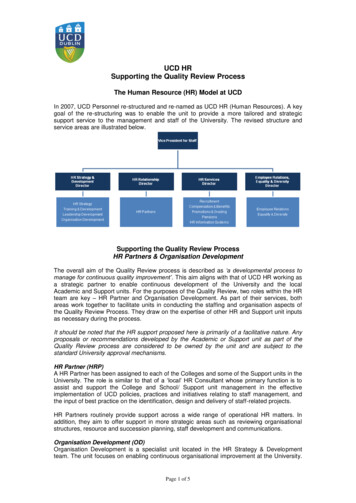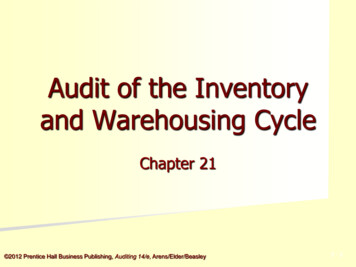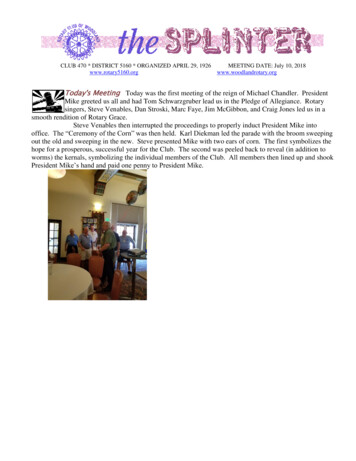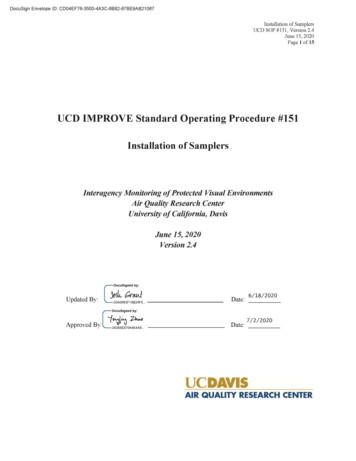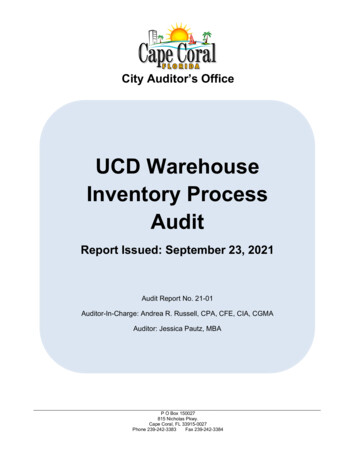
Transcription
City Auditor’s OfficeUCD WarehouseInventory ProcessAuditReport Issued: September 23, 2021Audit Report No. 21-01Auditor-In-Charge: Andrea R. Russell, CPA, CFE, CIA, CGMAAuditor: Jessica Pautz, MBAP O Box 150027815 Nicholas Pkwy.Cape Coral, FL 33915-0027Phone 239-242-3383Fax 239-242-3384
TO:Mayor Gunter and Council MembersFROM:Andrea R. Russell, City Auditor DATE:September 23, 2021SUBJECT:Utilities Collection and Distribution (UCO) Warehouse Inventory Process AuditThe City Auditor's Office has completed the audit of the UCO Warehouse Inventory Process.The audit was conducted in conformance with Generally Accepted Government AuditingStandards by the authority granted through City Ordinances 28-02 and 79-10.We would like to express our sincere appreciation to the Utilities Department management andstaff for the courtesy, cooperation and proactive attitude extended to the team members duringthe audit. If you have any questions or comments regarding this audit, please contact AndreaRussell at 242-3380 or Jessica Pautz at 242-3382.C: Rob Hernandez, City ManagerConnie Barron, Assistant City ManagerDolores Menendez, City AttorneyKimberly Bruns, City ClerkJeff Pearson, Utilities DirectorAl Casing, Collection and Distribution ManagerSteven Perun, Warehouse SupervisorKris DuFault, Professional Compliance OfficerAudit Committee2IP a g e
EXECUTIVE SUMMARY . 4BACKGROUND . 4AUDIT OBJECTIVES . 5STATEMENT OF AUDITING STANDARDS . 5FINDINGS AND RECOMMENDATIONS . 5SCOPE AND METHODOLOGY . 16APPENDIX A . 173 Page
EXECUTIVE SUMMARYThe City Auditor’s Office conducted a performance audit of the UCD Warehouse InventoryProcess. This audit is not included in the City Auditor’s FY21 approved Audit Plan; however, itwas added to the plan after the Office conducted a review of the UCD Warehouse Inventoryprocesses.Based on the test work performed and the audit recommendations noted below, we concludedoverall that policies and procedures are in place; however, controls over inventorymanagement, purchasing, and receiving need improvement. We noted control deficiencies inthe following areas: Inventory safeguarding Warehouse Standard Operating Procedures (SOPs) Inventory management Issue Sheet management and processing Warehouse purchase order managementFor further details on these findings and recommendations, see the Findings andRecommendations section. While we noted a lack of controls in some areas (lack ofsegregation of duties in purchasing, purchase receiving, and inventory management), nomaterial control deficiencies were noted.BACKGROUNDThe City of Cape Coral (City) was incorporated in 1970. The population has grown toapproximately 200,000 residents currently. Utility operations and maintenance are handled bythe UCD Division which is made up of three sections: water, sewer, and irrigation.UCD is responsible for the operation and maintenance of over 2,400 miles of water, sewer andirrigation piping as well as meters, valves, fire hydrants, and manholes in the city. In order foroperations and maintenance to be conducted, UCD must maintain inventory of items such asvarious size pipes, fittings, meters, hydrants, and manholes. This inventory is kept at the UCDWarehouse (Warehouse) which is currently staffed by one Supervisor and three InventoryClerks.According to the Warehouse SOPs, the mission of the Warehouse is to acquire, stock, andissue all parts and tools needed to install and maintain the City’s water, irrigation, and sewerinfrastructure. Annually as part of the City’s financial statement audit a physical inventory mustbe conducted. As of the latest year-end inventory conducted October 1, 2020, the Warehousehad approximately 1,000 items, totaling approximately 1.5 million.4 Page
AUDIT OBJECTIVEThe audit objective was to determine if controls over the UCD Warehouse inventory processare in place to ensure inventory is properly safeguarded and reported inventory amounts areaccurate and complete.STATEMENT OF AUDITING STANDARDSWe conducted this performance audit in accordance with Generally Accepted GovernmentAuditing Standards. Those standards require that we plan and perform the audit to obtainsufficient, appropriate evidence to provide a reasonable basis for our findings and conclusionsbased on our audit objectives. We believe that the evidence obtained provides a reasonablebasis for our findings and conclusions based on our audit objectives.FINDINGS AND RECOMMENDATIONSFINDING 2021-01 Safeguarding of UCD Inventory Needs ImprovementRank: HighCondition:Physical SafeguardingThe Warehouse is considered “closed” access to others outside of Warehouse personnel.Closed access means that only authorized individuals have access to the Warehouse. TheWarehouse consists of one main building, three Quonset huts, and various areas near thesebuildings, referred to as “the yard,” where inventory is stored outside being exposed to theelements. Although the City considers this a “closed” facility, the property, and those inventoryitems stored onsite, are accessible by non-UCD staff, such as Public Works Fleet as well asthe public. Items stored in the yard can be seen and possibly accessed from the road. TheWarehouse and yard have surveillance cameras which, until recently, are not monitored bydesignated staff. Warehouse I is considered the main warehouse location which housesinventory items that can be easily stored in bins and is also the location for staff offices. This isthe only building where access is partially restricted by badge or key. The side of the buildinghas a gate that is not locked. The other three Quonset huts are open with no restricted access.Records from Facilities indicate that 69 individuals have access to the Warehouse. 64 (93%)are not Warehouse personnel.Software AccessAccording to software access reports, a total of 12 individuals, including Utilities (seven) andFinance personnel (five), can make inventory modifications; however, one of the 12 (8%) areno longer employed with the City. Of the seven individuals in Utilities five individuals work inthe Warehouse with direct access to inventory items. Of the five, four individuals (80%) areInventory Clerks and should not have the authority to make adjustments in the software.5 Page
Criteria: Warehouse Standard Operating Procedures GAO-02-447G: Executive Guide: Best Practices in Achieving Consistent, AccuratePhysical Counts of Inventory and Related Property Physical security Restricted access to softwareCause: Physical security needs improvement Monitoring needs improvement Controls need improvement Inappropriate/ outdated software access Incomplete/ unclear SOPsEffect: Potential theft of inventory Increased risk of unauthorized access Noncompliant with SOPsRECOMMENDATIONS:2021-01a: Improve physical security in and around the warehouse to ensure only authorizedindividuals have access to inventory.2021-01b: Improve monitoring of software access to ensure proper safeguarding of inventoryrecords and segregation of duties where appropriate to ensure only appropriate individualshave access to software.Management Response and Corrective Action Plan:2021-01a. On August 13, 2021, UCD received the purchase order for Smith Fence to installthe warehouse perimeter fence. On August 31, 2021 the perimeter fenceconstruction is complete and secure metal storage containers are in place whichimproved access and security.2021-01a. Responsible Person: Collection and Distribution Manager2021-01a. Anticipated Completion Date: September 3, 20212021-01b. Access to the UCD Warehouse software is reduced to 5 employees. Of the fiveemployees, two are read-only, and three are able to utilize Tyler Munis so theycan receive, pay, and order parts inventory. At a minimum, one UCD Warehouseemployee will be assigned after-hours when crews need parts for emergencyrepairs. UCD will incorporate in the SOP to have ITS Department and Facilitiesto provide annual software and door access reports respectively for thewarehouse.2021-01b. Responsible People: Collection and Distribution Manager2021-01b. Anticipated Completion Date: October 29, 20216 Page
FINDING 2021-02 Warehouse SOPs Need Improvement to Ensure Inventory AccuracyRank: HighCondition:Cycle Count ObservationsWarehouse SOPs state cycle counts are completed periodically. Inventory levels are verifiedby the completion of cycle counts. As part of our audit, we reviewed the cycle count process.We noted that cycle counts are not completed on a regular basis in the Warehouse. Also,different sources indicate different time frames for completing cycle counts. For example, theWarehouse SOP states cycle counts are completed periodically; the UCD WarehouseSupervisor job description states weekly; and correspondence with the Warehouse indicatescounts are done daily. As part of the audit, we planned to observe two cycle counts. The firstcount was conducted a day early due to Warehouse staffing availability. While we were notable to observe, we did review the documentation from the count. We noted that variancesexist, and the count was not conducted blindly. We observed another cycle count and notedthe following: The item location on the report was not accurate Variances between quantity on the report and actual counts Cycle counts are not conducted blindlyCycle Counts ReviewedAs part of audit testing, we reviewed a sample of ten weeks to determine if cycle counts werecompleted in accordance with SOPs. According to sources, cycle counts should be conductedin the following manner: Weekly (at a minimum) Blind If variances exist, another count must be performed by a separate individualBased on testing, we noted seven of the 10 weeks (70%) did not have a corresponding cyclecount conducted. Of the ten weeks, three weeks had cycle counts; however, all three (100%)of those counts were not completed in a blind manner. A blind inventory count indicates theindividual counting the items, does not know what inventory amount is recorded in the software.Lastly, identification of a second individual counting the variances was difficult as no signatureor initials were present in two of the three (67%) instances.Populationtested forattributeNumber ofexceptionsExceptionPercentageCycle count was not completed10770%Cycle count was not considered blindTwo separate people did not completethe counting if a variance was present33100%3267%7 Page
Inventory AdjustmentsAs defined in inventory procedures, cycle counts are conducted in addition to year-endinventory. During the cycle counts process, adjustments to inventory may be necessary. Oncean Inventory Clerk completes a cycle count, the results are entered into Tyler Munis by theSupervisor who generates a variance report. All variances are counted by a second individual,generally the Supervisor. If the variance is deemed correct by the Supervisor an automatedadjustment occurs. As part of the audit, we reviewed the process and documentation formodifications to inventory items. We noted of three cycle counts completed, there were 73items verified and 32 (44%) had a variance. Of these 32, 16 (22%) had a variance greater thanfive items.Audit conducted cycle countsAs part of testing for the audit we judgmentally selected a sample of 40 inventory items from apopulation of 1,289 to conduct our own cycle count. This resulted in a sample tested of 40inventory items, two items were considered inactive; therefore, our sample consisted of 38active items. While conducting walkthroughs of the Warehouse and accompanying yard wenoted that items are moved from one location to another frequently, or that one item can befound in several locations. We also noted the following: Variances between actual count versus amounts recorded in the softwareo Some variances greater than five items Inaccurate item location in software Methodology for recording items in software does not agree to how items are purchasedor disbursedo For example, oil is purchased by quart; however, it is recorded in the software bytotal ounces and disbursed in three-ounce quantities.The results of our testing are below:Number ofExceptionsExceptionPercentageVariance between actual count andrecorded count2668%Items with a variance greater than 5Items with inaccurate location81721%45%Criteria: Warehouse Standard Operating Procedureso Inventory Control Sections UCD Warehouse Supervisor Job Description GAO-02-447G: Executive Guide: Best Practices in Achieving Consistent, AccuratePhysical Counts of Inventory and Related PropertyCause: Insufficient oversight8 Page
Controls need improvementInsufficient/ unclear SOPsInsufficient review of adjustmentsEffect: Potential theft of inventory items Inaccurate inventory totals Cycle counts not conducted in accordance with SOPs Inaccurate write-off of inventory itemsRECOMMENDATIONS:2021-02a: Revise inventory SOPs to ensure inventory counts are accurate and complete.Procedures, at a minimum, should include the following: Cycle countso Define who performs countso Frequency of counts Threshold for inventory adjustments in accordance with best practices (i.e., 5% errorrate) To ensure accurate counts are performed in accordance with SOPs Standardization of methodology of measuring items (i.e., gallons vs containers) Standardize the process for review and authorization of variance adjustments Recording of inventory items1 Tracking of inventory items1 Re-ordering of inventory items1 Management and disposal of obsolete inventory items12021-02b: To account for inventory stored in different locations, conduct an inventory itemwalkthrough to verify location accuracy and update software as needed.Management Response and Corrective Action Plan:2021-02a. The UCD Manager will work with UCD Warehouse staff to modify and improvethe current Standard Operating Procedures to ensure inventory accuracy. Theauditor’s recommendations will be incorporated into the new UCD WarehouseStandard Operating Procedures.2021-02a. Responsible Person: Collection and Distribution Manager2021-02a. Anticipated Completion Date: December 30, 20212021-02b. The UCD Manager conducted an inventory item walkthrough with UCDWarehouse staff on September 10, 2021 to verify the location of each warehouseitem and document the physical location in the inventory software.2021-02b. Responsible People: Collection and Distribution Manager2021-02b. Anticipated Completion Date: September 23, 20211See Recommendation 2021-03b9 Page
FINDING 2021-03 Inventory Management Needs ImprovementRank: HighCondition:Recording of InventoryLarge inventory items, such as fire hydrants and water meters, are stored uncovered in theyard. As part of the audit, we judgmentally selected18 items to obtain inventory data such aspurchase orders and financial software supporting documentation. Seven of the 18 items (39%)were not recorded in the software. We were unable to determine the cost of these items sinceno records exists. We inquired of warehouse staff as to why these items were not recorded asinventory. We received the following responses: Item was purchased years ago The item was given to the Warehouse from another department Items were extra material from a project within another department KIT A’s (purple irrigation connections) are installed at every residential property. Theyare assembled at the Warehouse and the parts that are used are issued out to theWarehouse prior to assembly. The completed product is not recorded in the software. Items are rented out to contractors for projects, not part of UCD inventoryOf the 11 items recorded in the software with the corresponding quantities on hand, there wasapproximately 126,000 of goods in the yard that were accounted for.Obsolete InventoryCurrently, no policies or procedures exist on monitoring and managing inventory, when to markan item inactive, or how to properly dispose of inventory. A review of 25 items from the masterinventory list reflected that 15 of the 25 (60%) where purchased prior to July 2019. In addition,with the items reviewed, there is an average of 1,136 days between when the item was lastpurchased compared to now.Re-ordering ProcessThe Warehouse SOPs outline a re-order process that states a report is run daily for items thathave reached a 15-day supply. To determine supply, pre-determined levels are set-up in thesoftware. The Warehouse SOPs are vague regarding the re-ordering process. As part of ourtesting, we determined that Warehouse staff follow one of two processes for re-ordering:1. Warehouse staff run a daily re-order report; physically verify quantities on the shelf; andadjust order amounts accordingly.2. Warehouse staff do not verify inventory counts prior to re-order. Orders are placedbased on quantity in software and pre-determined supply that should be recorded ininventory.Criteria: Warehouse Standard Operating Procedureso Section: Re-order Report AR 23 – Purchasing10 P a g e
o Sections: Certified Agency Buyer (CAB); Receiver; and Process for Purchasingand ReceivingCouncil approval for disposal of obsolete itemsCause: Weak inventory management Lack of controls Insufficient procedures Inconsistent processes Non-compliance with City/UCD policies and proceduresEffect: Potential theft of inventory Inventory amounts are inaccurate Under/overstated inventory amounts Storage of unnecessary materials Unnecessary purchases Excess inventory in WarehouseRECOMMENDATIONS:2021-03a: Record all inventory that is on premise upon receipt.2021-03b: Define the process for: Recording of inventory items Tracking of inventory items Re-ordering of inventory items Management and disposal of obsolete inventory itemsThis should be incorporated in Recommendation 2021-02a.Management Response and Corrective Action Plan:2021-03a. All inventory that is received by UCD Warehouse personnel will be immediatelybe recorded upon receipt and updated in the UCD Warehouse software forproper tracking and control. The standard operating procedures will be strictlyfollowed.2021-03a. Responsible Person: Collection and Distribution Manager2021-03a. Anticipated Completion Date: October 29, 20212021-03b. As previously stated in Auditor’s recommendation for 2021-02a, the UCDManager will work with the UCD Warehouse staff to modify and improve thecurrent Standard Operating Procedures to ensure inventory accuracy. Theauditor’s recommendations will be incorporated into the new UCD WarehouseStandard Operating Procedures.2021-03b. Responsible Person: Collection and Distribution Manager2021-03b. Anticipated Completion Date: December 30, 202111 P a g e
FINDING 2021-04 Issue Sheet Management and Processing Need ImprovementsRank: HighCondition:Issue sheets are completed by individuals requesting inventory. The issue sheet has asignature line for Warehouse personnel to sign to account for who is issuing versus who isentering the inventory into the software system. An “Issued By” signature was not available on23 of the 42 (55%) issue sheets and an “Entered By” signature was missing on 3 of the 42 (7%)issue sheets. Out of the 42 issue sheets reviewed, 19 had both signatures; however, 18 of the19 (95%) were signed by the same individual. Without defined roles and separation betweenissuance and processing within the software increases the risk of theft. During review of issuesheets, adjustments were made on 22 of the 42 issue sheets. Of those 22 issue sheets, 21(95%) of them did not have a signature or explanation to support the change. Without anysupport or acknowledgement of the adjustments made on the sheets, there is no way todetermine who made the adjustment and was it made with the requestor. This increases therisk of theft.In addition, issue sheets are supposed to be processed daily; however, there is no time framedefined in the Warehouse Standard Operating Procedures. Based on our testing, wedetermined 19 out of 41 (46%) issue sheets were not entered in the software on the day theissue sheet was completed. It is important to note that issue sheets are entered on average bythe following day; however, this timing affects cycle counts and other Warehouse processes.We reviewed 42 issue sheets and noted six instances (14%), where inventory was not properlyrecorded from the issue sheet to the financial system. Within the six instances, either inventorywas never adjusted, a different amount was entered, or inventory was adjusted to the wrongitem number. The SOPs do not define a monitoring process to identify inventory amounts areaccurate.As part of our audit, we conducted a walkthrough of the inventory process at Charlotte County.As part of Charlotte County’s process, inventory requests are submitted electronically throughthe software system. This allows for supervisors to approve inventory prior to being billed totheir respective department. This also allows Warehouse staff to gather inventory prior to crewsarriving. This gives the Warehouse the ability to know inventory counts instantly, reduceshuman error in interpretating individual handwriting, and saves time for crews working in thefield. Another advantage is that crews can transfer material from truck to truck in the event ofan emergency.Criteria: Warehouse Standard Operating Procedures – Section: Inventory Stock IssuesCause: Insufficient segregation of duties Unclear Policies and Procedures Insufficient monitoring Manual process12 P a g e
Effect: Inaccurate inventory amounts Potential theft of inventory Inefficient, time-consuming processRECOMMENDATIONS:2021-04a: To eliminate confusion and reduce improper procedure, update Warehouse SOPsto clearly define: Roles for issuing vs. recording inventory Proper procedure for adjustments or changes to inventory amounts Define time standards for processing issue sheets On-going monitoring to ensure amounts are correct and process is followed2021-04b: Consider establishing automated, live time inventory request to improve efficienciesand reduce errors.Management Response and Corrective Action Plan:2021-04a. The UCD Manager will work with UCD Warehouse staff to modify and improvethe current Standard Operating Procedures to ensure inventory accuracy. Theauditor’s recommendations will be incorporated into the new UCD WarehouseStandard Operating Procedures.2021-04a. Responsible Person: Collection and Distribution Manager2021-04a. Anticipated Completion Date: December 30, 20212021-04b. The UCD Manager and UCD Warehouse staff have been diligently working withthe IT Department on the implementation of the new Tyler Enterprise AssetManagement program. Staff has reached out to IT to consider implementation ofan automated, live time inventory software program to improve efficiencies andreduce inventory tracking errors if a better system can be procured.2021-04b. Responsible Person: Collection and Distribution Manager 22021-04b. Anticipated Completion Date: (Plan) March 31, 20222021-04b. Anticipated Completion Date: (Automation) August 31, 2022FINDING 2021-05 Warehouse Purchase Order Management Needs ImprovementRank: HighCondition:UCD Warehouse follows City procurement policies and procedures. Purchasing and receivingpolicies and procedures are included in three separate documents (Administrative Regulation23, the Purchasing Division’s Procurement Manual, and UCD Warehouse SOP).This finding has two Anticipated Completion dates. One for the plan for implementation based on processchanges and improvements and one for the software automation “go-live”213 P a g e
AR 23AR 23 states a Certified Agency Buyers (CABs) have the authority to obtain quotes forpurchasing requests; and upon receipt of the hard copy of the purchase order, place the orderwith the vendor. It is important to note that CABs have the ability to “receive” ordered items inthe financial software. AR 23 further states the receiver’s primary responsibility, when goodsare physically received, is to review the packing slip of items purchased, physically inspectitems, and confirm that the items received are the items ordered. The AR also states that wherepersonnel demands allow, the receiver shall always be someone different than the CAB.Currently, all Warehouse personnel are considered CABs and receivers. This creates asegregation of duties issue whereby the same individual who purchased items can alsophysically receive them and enter their receipt in the system.Purchasing Division’s Procurement ManualThe Procurement Manual outlines procedures, in conjunction with AR 23, for the receiving ofgoods and materials. The manual states, upon receipt, materials are to be inspected and thedelivery ticket signed, noting the quantity received and then it is forwarded to the respectiveCAB for processing. A signature on the receiving report (packing slip) signifies the items havebeen properly received, inspected, and accepted. We reviewed a sample of purchase orders(POs) and noted the following: The City of Cape Coral utilizes the National Institute of Governmental Purchasing, Inc.Commodity/Services Code Book to establish inventory item numbers. Therefore, itemnumbers and descriptions on the packing slip do not match item numbers anddescriptions on the purchase orders.o As part of our audit, we conducted a walkthrough of the inventory process in LeeCounty. We noted that their inventory item numbers ending digit matches thevendor inventory item number to allow for better identification of items. It is difficult to determine when material was physically received and item quantities anddescriptions were verified because the PO will have a check mark or circle around thequantity indicating the material was verified for accuracy; however, supporting initials ordates are not written on the PO to demonstrate who physically inspected the items anddelineate when goods were received.Warehouse SOPsThe Warehouse SOPs describe procedures on how to complete a purchase order and how toreceive material; however, a time standard of when inventory needs to be added to the softwaresystem is not defined. 10 of 58 (17%) were not entered on the same day that the material wasreceived. Furthermore, three out of 58 (5%) were not entered within 24 hours of receiving. 25out of 56 (45%) PO’s tested, had the same purchaser and receiver signature on the packingslip.Criteria: Warehouse Standard Operating Procedures – Section: Purchase Order Receiving Procurement Manual: Section 16, Receipt of Goods & Materials AR 23: Purchasing: Sections Certified Agency Buyer (CAB), Receiver, Process forPurchasing and Receiving, and Purchasing Invoicing Procedures14 P a g e
Cause: Insufficient segregation of duties between purchaser and receiver Vague policies and proceduresEffect: Inaccurate inventory amounts Potential theft of inventoryRECOMMENDATIONS:2021-05a: To ensure appropriate segregation of duties for the receiving and recording ofinventory items, follow City policies and procedures in AR23 and the Purchasing DivisionProcurement Manual, and designate separate Certified Agency Buyers (CABS) and receivers.2021-05b: To ensure inventory items are accurately received, develop a system that allows foreasy verification of item numbers and descriptions in comparison to purchase orderinformation. (i.e., utilizing pictures of items)Management Response and Corrective Action Plan:2021-05a. The UCD Manager will work with the UCD Warehouse staff to ensure that theCertified Agency Buyer is not the same person who receives the warehousematerial as set forth in AR-23 and any guidelines established by the PurchasingDivision. The updated Standard Operating Procedures will include clear andconcise procedures.2021-05a. Responsible Person: Collection and Distribution Manager2021-05a. Anticipated Completion Date: September 30, 20212021-05b. The UCD Manager will work with the UCD Warehouse staff to update theStandard Operating Procedures to ensure quick and efficient verification of itemnumbers and descriptions and we will utilize pictures of the items.2021-05b. Responsible Person: Collection and Distribution Manager2021-05b. Anticipated Completion Date: December 30, 202115 P a g e
SCOPE AND METHODOLOGYBased on the work performed during the planning and the assessment of risk, the audit coversUCD Warehouse Inventory Process for the period of September 1, 2020 to May 31, 2021.Testing was performed using applicable Administrative Regulations, the Purchasing Division’sProcurement Manual, and UCD policies and procedures that were in place during the scope.Original records as well as copies were used as evidence and verified through physicalexamination. Sample size and selection were based on the CAO Sample Methodology. To gaina better understanding and to ensure Warehouse SOPs were being followed, cycle countswere observed and documented. Judgmental sampling was utilized to select samples forobservation of cycle count completion by Warehouse; CAO reperformance of inventory countsfor selected items; tracing items to financial system; obsolete inventory item selection; andissue sheet compliance testing. The tests above support the objective to determine if controlsare in place to support that inventory is accurate and complete. Random sampling was utilizedto select purchase orders to determine compliance with policies and p
Sep 23, 2021
